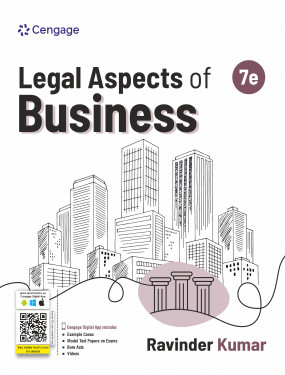
Legal Aspects of Business
ISBN: 9789366603902

eBook for Legal Aspects of Business
ISBN: 9789366606361
Higher Education

Author(s): Richard A. Mann | Barry S. Roberts
ISBN: 9781305477155
12th Edition
Copyright: 2016
Binding: eBook
This uses a nontechnical presentation to help your students understand the dynamics of today's legal environment for business. *Special prices for countries of South-Asia
Chapter 1: Introduction to Law
Chapter 2: Business Ethics
Chapter 3: Civil Dispute Resolution
Chapter 4: Constitutional Law
Chapter 5: Administrative Law
Chapter 6: Criminal Law
Chapter 7: Intentional Torts
Chapter 8: Negligence and Strict Liability
Chapter 9: Introduction to Contracts
Chapter 10: Mutual Assent
Chapter 11: Conduct Invalidating Assent
Chapter 12: Consideration
Chapter 13: Illegal Bargains
Chapter 14: Contractual Capacity
Chapter 15: Contracts in Writing
Chapter 16: Third Parties to Contracts
Chapter 17: Performance, Breach, and Discharge
Chapter 18: Contract Remedies
Chapter 19: Introduction to Sales and Leases
Chapter 20: Performance
Chapter 21: Transfer of Title and Risk of Loss
Chapter 22: Product Liability: Warranties and Strict Liability
Chapter 23: Sales Remedies
Chapter 24: Form and Content
Chapter 25: Transfer and Holder in Due Course
Chapter 26: Liability of Parties
Chapter 27: Bank Deposits, Collections, and Funds Transfers
Chapter 28: Relationship of Principal and Agent
Chapter 29: Relationship with Third Parties
Chapter 30: Formation and Internal Relations of General Partnerships
Chapter 31: Operation and Dissolution of General Partnerships
Chapter 32: Limited Partnerships and Limited Liability Companies
Chapter 33: Nature and Formation of Corporations
Chapter 34: Financial Structure of Corporations
Chapter 35: Management Structure of Corporations
Chapter 36: Fundamental Changes of Corporations
Chapter 37: Secured Transactions and Suretyship
Chapter 38: Bankruptcy
Chapter 39: Securities Regulation
Chapter 40: Intellectual Property
Chapter 41: Employment Law
Chapter 42: Antitrust
Chapter 43: Accountants’ Legal Liability
Chapter 44: Consumer Protection
Chapter 45: Environmental Law
Chapter 46: International Business Law
Chapter 47: Introduction to Property, Property Insurance, Bailments, and Documents of Title
Chapter 48: Interests in Real Property
Chapter 49: Transfer and Control of Real Property
Chapter 50: Trusts and Wills
APPENDICES
INDEX
Richard A. Mann, The University of North Carolina at Chapel Hill
Barry S. Roberts, The University of North Carolina at Chapel Hill